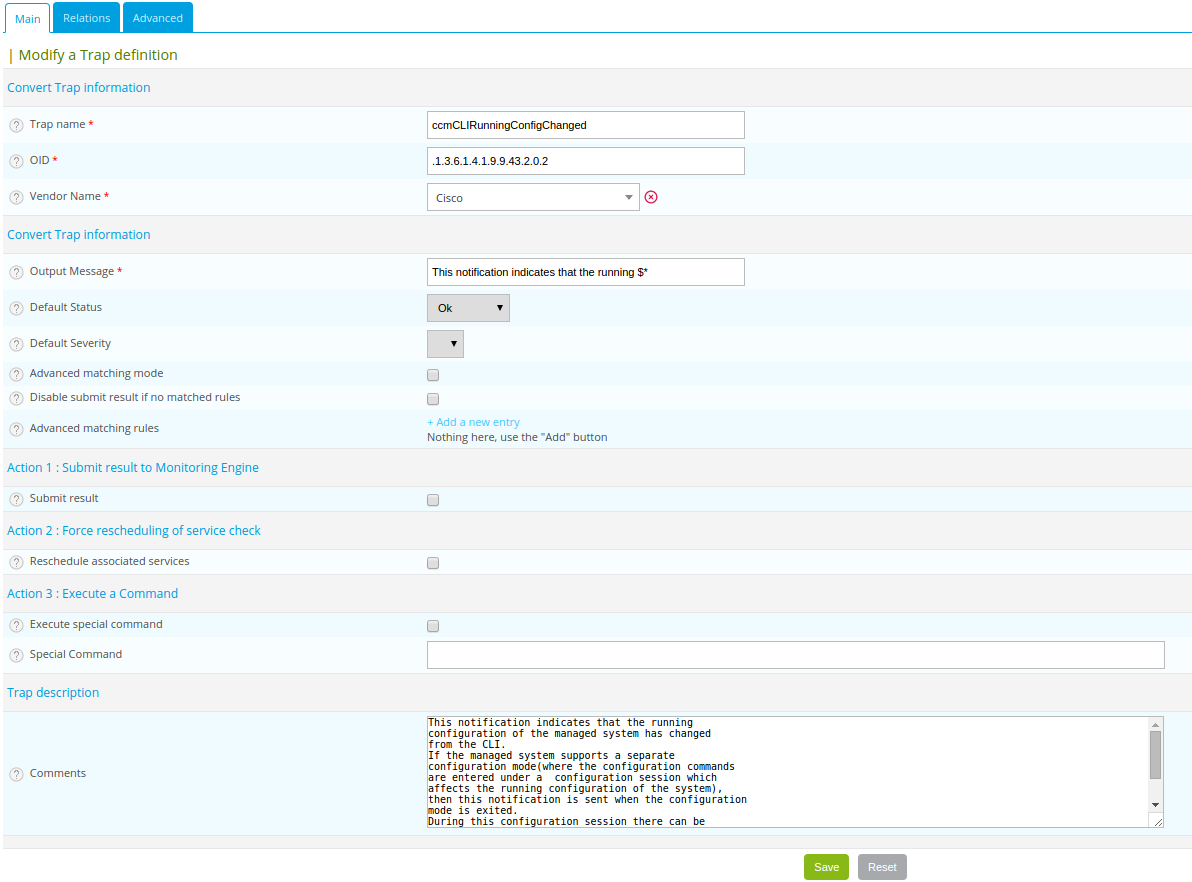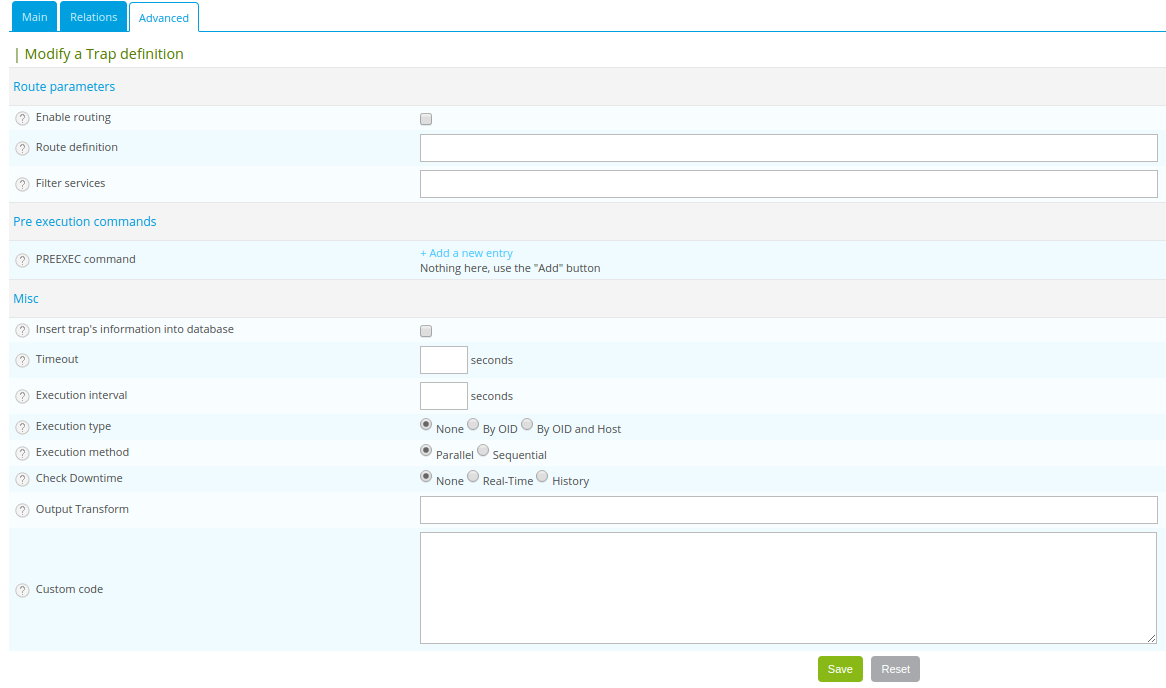Create SNMP Traps definitions
Add a manufacturer
Within centreon, the root OIDs of the SNMP traps is filed by manufacturer. To add a manufacturer:
Go into the Configuration > SNMP traps > Manufacturer menu and click on Add
- The Name and Alias fields define the name and the alias of the manufacturer
- The Description field provides an indication about the manufacturer
Import SNMP traps from a MIB file
Go into the Configuration > SNMP traps > MIBs menu

- The Manufacturer list can be used to choose the manufacturer to which the MIB that you are importing belongs
- The File (.mib) field can be used to load the MIB
Prior to importing a certain MiB file, it may happen that a number of dependencies need to be met. In order to find the dependencies of your MIB, you must open your MIB file using a standard text editor, then:
- Locate the line that starts with IMPORTS
- Verify all the required dependencies to import your MIB file after the keyword FROM

In the MIB file shown above, there are four dependencies required to import the MIB: SNMPv2-SMI, SNMPv2-TC, SNMPv2-CONF, SNMP-FRAMEWORK-MIB.
The dependencies of the MIBS that you import must be present in the folder /usr/share/snmp/mibs. Once the import is completed, delete the dependencies previously copied.
Manual configuration of traps
Basic configuration
It is also possible to create definitions of SNMP traps manually:
Go into the Configuration > SNMP traps > SNMP traps menu and click on Add

- The field Trap name defines the name of the trap.
- The field Mode defines how to check the trap OID received.
- The field OID defines the Root OID to be received for this trap to be considered as received.
- The field Vendor name defines the name of the manufacturer to which the trap to be selected in the drop-down list belongs.
- The field Output message of contains the message to be displayed in the event of reception of a trap containing the OID configured above.
By default, the MIB contains the definition of this variable (E.g.: “Link up on interface $2. State: $4.”, here $2 will be replaced by the 2nd argument received in the event.). In the opposite situation, the variable $* can be used to display all the arguments contained in the trap.
It is possible to construct the output message yourself. For this, use the MIB to know the arguments that will be present in the body of the event and retrieve the arguments with the variables $n. As each argument is identified by a OID, it is possible to use this OID directly to place it in the output message without knowing its position via the variable @{OID}.
- The Default status field defines the “monitoring” status of the service in case of reception of the trap.
- If the Submit result box is checked the result is submitted to the Network supervisor engine.
- The Comments field (last field) contains by default the comment by the manufacturer of the SNMP trap. Most of the time, this comment indicates the list of variables contained in the SNMP trap (see the next chapter on advanced configuration).
Advanced configuration of the traps
It is possible to determine the status of a service from the value of a setting of the SNMP trap rather than from the Root OID. Previously the manufacturer defined an SNMP trap (Root OID) by type of event to be sent (linkUp / linkDown). Today, the tendency is to define a Root OID by category of events and then to define the event via a set of settings.
To do this, it is possible of define Advanced Matching mode by clicking on Add a new entry and by creating as many rules as necessary. For each rule, define the settings:
- String defines the element on which the search will be applied (@OUTPUT@ defined all the Output messages translated).
- Regexp defined the REGEXP type search to be applied.
- Status defines the status of the service in the event of concordance.
The order is important in the rules of correspondence because the process will stop at the first rule of which the correspondence is assured.
- The Disable submit result if no matched rules field disables the sending of information to the scheduling engine if no correspondence with a rule is confirmed.
- If the Reschedule associated services box is checked, the next check on the service, which should be ‘active’, should be reprogrammed as soon as possible after reception of the trap.
- If the Execute special command box is checked, the command defined in Special command is executed.
Advanced tab
The Advanced tab serves to configure the behavior of the handling process of the SNMP traps on its reception of the latter.

- Enable routing is used to enable the routing of information.
- Route definition is used to define the command to be used for routing.
Before performing the processing of the event (translation of the Output message), it is possible to execute a command called PREEXEC. To do this, it is possible to define PREEXEC command (SNMPTT type) by clicking on Add a new entry and create as many rules as necessary.
- PREEXEC command defines the command to be executed.
Here is an example of use with the linkUP trap:
For a Cisco equipment, $2 == ifDescr contains the port number of the interface (GigabitEthernet0/1 for instance). The best description of the interface is in the SNMP if Alias field.
The following command can be used to retrieve this value:
snmpget -v 2c -Ovq -c <community> <cisco switch> ifAlias.$1
To use the result of the PREEXEC command in the Output message, it is necessary to use the variable $p{n} where ‘n’ corresponds to the order of definition of the command.
Example:
"Interface $2 ( $p1 ) linkUP. State: $4." "$CA"
The result will have the form: Interface GigabitEthernet0/1 ( NAS Server ) linkUP. State: up
- The Insert trap's information into database box, if checked, record the SNMP trap information in the database field can be used define whether or not to classify the traps by day in the database.
- The Timeout field expressed in seconds is used to define the maximum processing time of the event including the pre-processing commands (PREEXEC) and post-processing commands (special command).
- The Execution interval field expressed in seconds is used to define the maximum waiting time between two processing operations of an event.
- The Execution Type field is used to enable the Execution interval by defining the conditions by Root OID, by the Root OID and host combination or, to disable this restriction, None.
- The Execution Method field is used to define if on reception of multiple same events (Root OID). The execution is either Sequential or Parallel.
Custom code
The field custom code allows custom Perl processing. To enable this feature, you must set secure_mode to 0 in /etc/centreon/centreontrapd.pm file as:
our %centreontrapd_config = (
...
secure_mode => 0,
....
);
1;
For example, to decode the 4 arguments from hexadecimal, the custom code will be:
if ($self->{trap_data}->{entvar}->[3] =~ /[[:xdigit:]]+/) {
my $hexa_value = $self->{trap_data}->{entvar}->[3];
$hexa_value =~ s/ //g;
$self->{trap_data}->{entvar}->[3] = pack('H*', $hexa_value);
}
Beware the argument table starts at 0 for argument 1 of the SNMP trap.
Variables
When adding a rule of correspondence or executing a special command it is possible to transmit arguments to the String or Special command fields. These arguments are listed in the table below:
| Macro name | Description |
|---|---|
| @{NUMERIC_OID} | Retrieval of the value of an argument via its OID, e.g.: @{.1.3.6.1.4.1.9.9.43.1.1.1} |
| $1, $2... | Retrieval of the value of an argument via its order of appearance |
| $p1, $p2,... | Value of the command: PREEXEC ($p1 = at the first command, $p2 at the second, ...) |
| $* | All the arguments separated by a space |
| @HOSTNAME@ | Host name (in centreon) to which the service is attached |
| @HOSTADDRESS@ | IP address of the host sending the trap |
| @HOSTADDRESS2@ | DNS name of the host sending the trap (if the server fails to effect a reverse DNS resolution we retrieve the IP address) |
| @SERVICEDESC@ | Service name |
| @TRAPOUTPUT@ ou @OUTPUT@ | Output of the traps |
| @STATUS@ | Service state |
| @SEVERITYNAME@ | Criticality name |
| @SEVERITYLEVEL@ | Criticality level |
| @TIME@ | Trap reception timestamp |
| @POLLERID@ | ID of the poller having received the trap |
| @POLLERADDRESS@ | IP address of the poller having received the trap |
| @CMDFILE@ | Path to the command file of central or of centreon Engine (collector) |
In addition, there are special variables that can be used in the Routing settings section at the level of the Routing command if the option Enable routing is selected:
| Macro name | Description |
|---|---|
| @GETHOSTBYADDR($1)@ | Reverse DNS resolution used to find the DNS name DNS from the IP address (127.0.0.1 -> localhost) |
| @GETHOSTBYNAME($1)@ | DNS resolution used to find the IP address from the DNS name (localhost -> 127.0.0.1) |